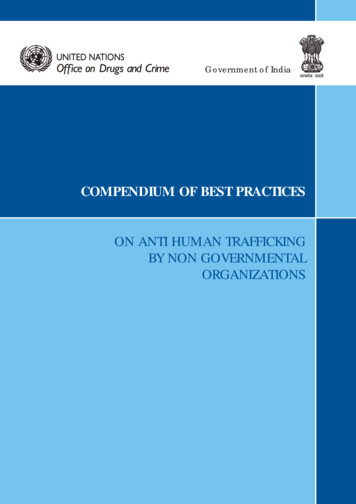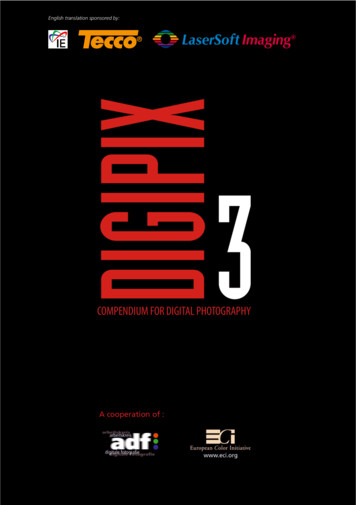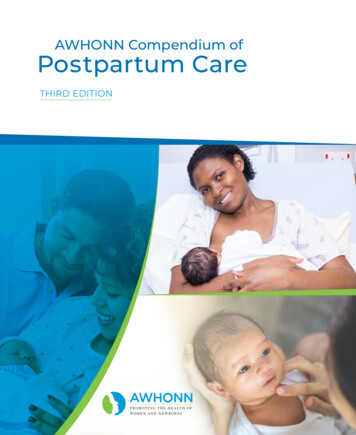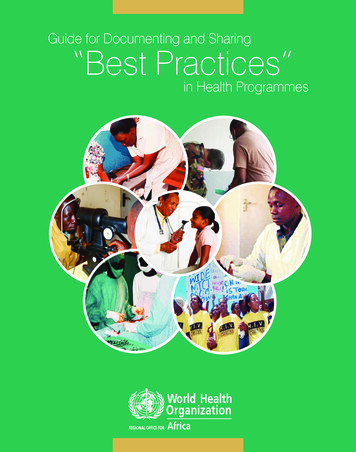
Transcription
Government of IndiaCOMPENDIUM OF BEST PRACTICESON ANTI HUMAN TRAFFICKINGBY NON GOVERNMENTALORGANIZATIONS
AcknowledgmentsACKNOWLEDGMENTSMs. Ashita Mittal, Deputy Representative, UNODC, Regional Office for South AsiaThe Working Group of Project IND/ S16:Dr. Geeta Sekhon, Project CoordinatorMs. Swasti Rana, Project AssociateMr. Varghese John, Admin/ Finance AssistantUNODC is grateful to the team of HAQ: Centre for Child Rights, New Delhifor compiling this document:Ms. Bharti Ali, Co-DirectorMs. Geeta Menon, ConsultantUNODC acknowledges the support of:Dr. P M Nair, IPSMr. K Koshy, Director General, Bureau of Police Research and DevelopmentMs. Manjula Krishnan, Economic Advisor, Ministry of Women and Child DevelopmentMr. NS Kalsi, Joint Secretary, Ministry of Home AffairsMs. Sumita Mukherjee, Director, Ministry of Home AffairsAll contributors whose names are mentioned in the list appendedIX
COMPENDIUM OF BEST PRACTICESON ANTI HUMAN TRAFFICKINGBY NON GOVERNMENTALORGANIZATIONS
UNODC, 2008Year of Publication: 2008A publication ofUnited Nations Office on Drugs and CrimeRegional Office for South AsiaEP 16/17, Chandragupta MargChanakyapuriNew Delhi - 110 021www.unodc.org/indiaDisclaimerThis Compendium has been compiled by HAQ: Centre for Child Rights for Project IND/S16 of United NationsOffice on Drugs and Crime, Regional Office for South Asia. The opinions expressed in this document donot necessarily represent the official policy of the Government of India or the United Nations Office onDrugs and Crime. The designations used do not imply the expression of any opinion whatsoever on thepart of the United Nations concerning the legal status of any country, territory or area or of its authorities,frontiers or boundaries.Back cover poster:Prajwala, HyderabadDesigned and printed by:INDIA PRINTSNaraina, New Delhi-110028Tel.: 011-25775419, 0 9811156600email: india prints@vsnl.netII
ContentsACKNOWLEDGMENTSPREFACEVIIPART IANTI-HUMAN TRAFFICKING INTIATIVES - THE NGO- CORPORATE PARTNERSHIP1.Rehabilitation and Social Re-integration of Trafficked victims: NGO-Corporate SectorPartnership model based on sound business logic and not just welfare andcorporate social responsibility . .32.NGO–corporate partnership in rehabilitating survivors: Unique initiatives by Sanlaapi.A lot can happen over a cup of coffee – Partnership between Sanlaap, CaféCoffee Day, ITC Sonar BANGLA and the EXPLOTEC Call Centre for the EconomicEmpowerment of Trafficking Survivors . 8ii.Sewing Dreams and Hopes for a Better Tomorrow: Sanlaap Partners withIOM and NIFT for the Skill Development and Economic Empowerment ofSurvivors of Trafficking . . 9iii.Entering a New Venue – Survivors as Maintenance Staff for IndianBank ATMs . . . 103.Trafficking of women migrant workers - A model for prevention: Ankuramand Modi Builders . . . 124.The C3 Market Place: A Jabala Initiative in Rehabilitation . . 165.Partnership Between ‘NGO-Corporate-Civil Society-Panchayat’ inAddressing Human Trafficking – A Jabala Initiative . . 186.Multi-Stakeholder Response to Human Trafficking: Kolkata Police Corporates-NGOs join hands on Anti Human Trafficking Initiatives . . . 217.Creating Awareness Through Puja Pandals: A Unique CollaborativeEffort by Fellowship in Preventing Human Trafficking in Orissa . 248.Microsoft Unlimited Potential: Microsoft Corporation Partners with NGOsin India to Combat Human Trafficking . 269.Combining Efforts in Prevention and Rehabilitation : Prayas Bharti Trustand the Bihar Chamber of Commerce . 2810.The Sanchay Prayas Model – Prayas, Amul and IOM Combine Forces forRehabilitation of Trafficked Victims . 31III
11.Preventing Human Trafficking by Empowering the most vulnerable:A Prayas- Microsoft Collaboration . 3412.Bollywood joins in the Anti Human Trafficking Initiative . 3713.Economic Rehabilitation of Victims of Trafficking: Prerana partners with theCorporate Sector for Training and Placement in Four Professions: treading anunchartered territory in NGO-Corporate synergy on anti human trafficking .i.Catering with Taj Mahal Hotel .ii.Housekeeping as a viable employment opportunity: Prerana with Taj Mahal Hotel.iii.Victim-Survivors as Petrol Fillers: Rehabilitating Victims with the Support of BPCL.iv.Fashion Garments Production: Prerana Combines Forces with NIFDand IOM to Rehabilitate Trafficked Victims and their Children .v.Rehabilitating Trafficking Victims: Prerana Combines Forces withITM Institute for Course on Hospitality and Catering . .39404141414214.‘Swift Wash’: A Public-Private Partnership on Rehabilitation, SocialRe-integration and Empowerment of Trafficked Victims in Goa . 4415.Reintegrating survivors – Sthree’s “Mix & Match” strategies in alternative livelihoods . 4716.Jet Airways–STCI Partnership Making a Difference: A Case Study of aCorporate - NGO Partnership Transforming the Lives of Many . . 5017.Corporate–Media–NGO Partnership in Advocacy on Anti-Human Trafficking:The Apne Aap Initiative . 5418.Linking Self Help Groups with International and Local Business Houses:Providing Sustained Livelihood Options to Survivors – Initiatives by Apne Aap .56Public awareness building through theatre: Campaign against ChildTrafficking (CACT) combines with corporate/ business houses .5919.PART – IIANTI-HUMAN TRAFFICKING INTIATIVES – NGOs COLLABORATE WITH SEVERAL STAKEHOLDERS ONPREVENTION, PROTECTION AND PROSECUTIONA.PREVENTION .6220.Religious Leaders Unite Against Human Trafficking – The Inter-ReligiousPriests Forum (IRPF) in Bihar .6321.Action against Trafficking and Sexual Exploitation of Children (ATSEC): A First Initiativein Networking among NGOs and International Agencies against Human Trafficking . 6622.Multi-pronged approach to preventing trafficking of children in the name ofreligious practices - The Vimochana Model . . 7223.Sakhi Educates Adolescents to Gear up to Fight for their Rights and StopTrafficking of Women and Girls . . . 7624.Contact Base uses theatre to sensitize and mobilize community led action inpreventing trafficking of women and children in Goa . 78IV
25.An innovative training program of i-land Informatics Limited for empowering policeconstables with knowledge, skills and attitude to stop human trafficking in West Bengal . 8226.Apne Aap Women Worldwide Addresses the Demand Factor throughAwareness, Advocacy, Capacity Building and Law Enforcement . 8527.Preventing Trafficking among Especially Vulnerable Groups – the Nutts,Bedias and Kanjars - The Apne Aap Women Worldwide Experience . 8828.ACKNOWLEDGMENTSLife Guard Centers – Manav Seva Sansthan (MSS) ‘Blows Whistle’ onTraffickers at the Indo-Nepal Border . . 9129.Trafficking in the Mahananda-Kosi belt – Bhoomika Vihar ensuresinvolvement of the community in Anti-Human Trafficking work . 9530.The Safe Migration Model of Jabala in Prevention of Trafficking fromMurshidabad & 24 Parganas-North, in West Bengal . 9931.NEDAN FOUNDATION seeks to reduce vulnerability by creating livelihoodoptions through best use of traditional skills . . 10232.MV Foundation facilitates and empowers Gram Panchayats to act asPreventive Agents against Child Trafficking . 10533.Reducing the Vulnerability of Fisher Women in Bihar – The Sakhi Experiencein Preventing Human Trafficking and Sexual Exploitation through Women’sEconomic Empowerment Initiatives . .109B.PROTECTION . 11234.Joint efforts of Panah Ashram, ATSEC- Bihar and Bihar Police in rescuing girlchildren from being trafficked into forced labor and sexual exploitation . . 11335.Controlling Trafficking for Domestic Labor – ATSEC Jharkhand takes upCudgels against Traffickers . . 11636.The Jogbani Counseling Center – Bhoomika Vihar’s efforts at arrestingtrans-border trafficking . 11837.Village Vigilance Committees and Information Booths act as the safety net: NedanFoundation’s initiative towards Preventing Human Trafficking and Unsafe Mobility.12038.Prayas Juvenile Aid Center Works towards Realizing the Rights of ChildSurvivors of Trafficking . 12239.Kishori Niketans set up by ATSEC Jharkhand facilitate and ensurerehabilitation and social re-integration of trafficked victims . . 12740.Viable Employment Options in Rehabilitation of Victims of Trafficking:A Case Study by STOP, Delhi . 12941.Community Social Rehabilitation – the other side of Anti Human Traffickingwork undertaken by Bhoomika Vihar . . 13142.STOP fights for Repatriation of Foreign Victims . 133V
C.PROSECUTION . 13643.Combating organized crimes through coordinated efforts – An effort of HAQ:Centre for Child Rights to ensure prosecution and justice in a case of illegalbaby sale through coordinated action . . 13744.Just Trust joins forces with Law Enforcement Agencies and like-mindedNGOs to Combat Trafficking of Women and Children for CommercialSexual Exploitation in Tamil Nadu . . . 13945.Role of NGO in Justice Delivery System – STOP Prosecutes Offenders inTrans-border Trafficking Case . 14246.Slavery and Sexual Exploitation of Trafficked Girls in Circuses – Bachpan BachaoAndolan Fights to End Employment of Children in the Entertainment Industry . 14447.NGO can also contribute to Prosecution: The importance of timely and well-plannedaction followed by Legal Aid and counseling Rescue Foundation’s experience atensuring prosecution of offenders and justice for the victims . . 14748.Strategic intervention and Optimization of Opportunities help STOP rescuetwo Nepalese girls and other minors from Delhi’s Red Light Area . 149FRAME WORK FOR A BEST PRACTICE CASE STUDY . . 152LIST OF ABBREVIATIONS . . . 156LIST OF CONTRIBUTORS . . .VI159
PrefaceACKNOWLEDGMENTSTrafficking of women and children is one of the gravest organized crimes, extending beyondboundaries and jurisdictions. Combating and preventing human trafficking requires a holisticapproach by all stakeholders and integrated action on prevention, protection and prosecution. Keeping this philosophy in mind, Project IND/S16 of the United Nations Office on Drugs andCrime, which is a joint initiative of UNODC and the Government of India and funded by the USGovernment, was launched in April 2006 in India. This project is focused on “Strengthening the lawenforcement response in India against trafficking in persons, through training and capacity building”. The major activities in the project are training of police officials and prosecutors, setting upintegrated Anti Human Trafficking Units, establishing networks among law enforcement agenciesand civil society partners as well as developing appropriate tools including Protocols, Manuals, Standard Operating Procedures (SOP), Compendiums and other training aids.Recognizing the need for partnership and action at various levels, many sectors and actors are joininghands for positive action and change. The present decade has seen tremendous initiatives undertakenby the civil society (including NGOs) in addressing the various issues of human trafficking. NGOs havecombined forces with the police, lawyers, the judiciary, media and the corporate sector and involvedthem in strategies and processes for prevention, protection, rehabilitation, prosecution and advocacy,as this Compendium on ‘Best Practices against Human Trafficking’ aims to show.The Compendium is divided into two parts. Part I highlights some successful initiatives of collaboration between NGOs and corporate/ business houses in combating trafficking. The other excellentinitiatives have been put together in Part II of this Compendium under three broad categories viz.Prevention, Protection (including rehabilitation, repatriation and restoration) and Prosecution.This Compendium has been put together through the combined efforts of UNODC, HAQ: Centre forChild Rights and all the NGOs whose work it represents. The case studies have been contributed byindividuals/ agencies/ organizations whose names have been indicated on page 159. Genuineness andveracity of the factual content rests with the contributors of the case studies. UNODC has takenresponsibility to facilitate collection, collation of these case studies and has been largely responsiblefor discussions and reviews to edit the case studies to make them brief and focused and, in thisprocess HAQ: Centre for Child Rights, New Delhi, has rendered commendable support.The Compendium will be an inspiration and model for all stakeholders to intensify their efforts inresponding to human trafficking through collaboration and cooperation.VII
VIII
PARTIAnti-Human TraffickingInitiatives - The NGO-CorporatePartnership
2
1Rehabilitation and Social Re-integration ofTrafficked victims: NGO-Corporate SectorPartnership model based on sound business logic andnot just welfare and corporate social responsibilityPrajwala, the ‘eternal flame’ began as a response to increased incidences of trafficking inAndhra Pradesh. The organization is devoted exclusively to the cause of women and childvictims and potential victims of trafficking, particularly for prostitution, which it considersto be the worst form of sexual slavery. Its activities include second-generation prevention, rescue,rehabilitation, restoration and social reintegration of victims of trafficking for commercial sexualexploitation. These objectives are achieved through a multi-pronged approach, as trafficking is amulti-dimensional problem. In keeping with this, Prajwala is actively involved in advocacy and innetworking with anti-trafficking organizations. During the process of implementation of variousprogrammes to combat causes of trafficking, Prajwala has evolved need based interventions andmethodologies which are mile stones for the organization and breakthroughs in the anti-traffickingsector.Prajwala’s Rehabilitation Model - a tall order, but clear objectives True social, economic and psychological rehabilitation is that which allows the victim to livewith dignity in the mainstream society, not away from it in separate settlements. Given thepersonal trauma that a victim has undergone, rehabilitation also implies a complete breakfrom the past life, its experiences and memories. Prajwala wants the rehabilitated survivor notto be identified as a ‘Prajwala girl’ by anyone, including herself. The NGO’s need should notbecome her burden.Prajwala has studied, negotiated, collaborated and partnered with all sectors of the society in itsvictim rehabilitation ventures. The corporate sector was a major challenge for Prajwala. It was clearto the organization that if the corporate sector has to partner with it, there has to be a soundbusiness logic to the partnership, not just that of welfare and corporate social responsibility. Mostof the corporate and business sector concerns need multi-skilled workers in large numbers and ifPrajwala could create such a work force, the firms would see the business sense in combiningforces. With this in mind, Prajwala began to understand the requirements of hospitals, the hospitalityindustry and the consumer market. It identified several sectors where its girls could fit in. Then itbegan active preparations for the same.Identification of need-based, aptitude based, market assessed, viable & sustainable economicoptions is critical for long term rehabilitation. As this group is specially stigmatized andtraumatized, the scope of social reintegration is limited. Any intervention for family basedtrades may not be suitable. Therefore, the options provided should be able to sustain thesurvivor’s life independently without dependence for basic sustenance. Effort is hence takento do a thorough market study before adopting any particular trade or employment option.Only those livelihood options are chosen which are viable in the job market.www. prajwalaindia.com3
Its first collaborative venture was with Amul, which was the first of its kind in the country. With thesuccess of the Amul parlour, Prajwala moved on to other industries such as hospital, hospitality andconstruction. When Prajwala began its Amul experiment it had no examples to go by, hence detailedpreparations were a must. Prajwala thus began at the very beginning — the first step was an attempt tounderstand the needs, strengths and limitations of the survivors. Based on the findings, IOM and Prajwalaprepared a 15 days induction training module designed to prepare the survivors for such a venture. Themodule was an innovation in itself and consisted of many components ranging from numeracy, literacy,spoken English, basic book keeping, grooming skills interspersed with practical exposure to real workingsituations.This module has formed the foundation of all Prajwala’s corporate collaboration ventures, as well as allits work at skill building of survivors.This series of 3 case studies go to show what makes a difference in partnering with corporate andbusiness houses as far as rehabilitation of victims of sexual exploitation is concerned. It also showsus what to watch out against and prepare ourselves for.Case 1 From Philanthropy to Partnership: The Prajwala - Amul CollaborationBack in 2002, when the concept of corporate partnership in anti human trafficking interventions was inits nascent stage and the corporate response was more about doling out either in cash or in kind,Prajwala was going through its own frustrations in evolving sustainable and viable economic options forsurvivors of trafficking for sexual exploitation. A chance meeting of Prajwala functionaries with AmitaJoseph (then in USAID) and Sarat Dash of IOM kicked off a whole new thought process of involving thecorporate sector in economic empowerment of survivors. After a lot of brain storming the idea of takingover franchises of known brands of products was accepted as a good area to explore. Amita Josephmade the first contact with Dr. V. Kurien, the founder and the man behind Gujarat Cooperative MilkFederation (GCMF). The positive response from Mr. Kurien built a new momentum towards an innovativepartnership model of civil society, the corporate sector and international organizations.The basic idea of the venture was that survivors of trafficking will run an Amul Pizza Parlour. There werefive partners in this venture: Amul IndiaInternational Organization for Migration(IOM)Government of Andhra PradeshPrajwalaThe SurvivorsAs the corporate partner, Amul provided the brand name as well as the on job training to run theparlour. Further it also provided the initial machinery such as a freezer at a nominal cost. As an internationalorganization, IOM provided the initial capital that was required to set up two parlours and also supportedin evolving a capacity building training module on life skills and entrepreneurial skills for survivors whowere to manage the parlour. As an indication of government support and collaboration, the Departmentof Women Development and Child Welfare facilitated the allocation of free space to establish theparlour. As the civil society partner, Prajwala provided shelter to the survivors during the process ofcapacity building, counseling support and also, with its contacts, facilitated the allotment of the place toset up the parlour. As a field based organization Prajwala also contributed in developing a survivorfriendly training module that kept the needs, aptitude, strengths and limitations of survivors in focus.Victims of trafficking, who were already on the road to recovery and could be termed as survivors, were4
the core partners in this innovative venture. Their willingness to explore the unknown and experimentwith it became the key force in initiating this model.Fifteen survivors were trained using the Prajwala comprehensive training module. Simultaneouslyappropriate locations were identified where the parlour could be located. Prajwala contacted theDepartment of Women Development and Child Welfare and the Tourism Department for space ingovernment offices and also in prominent tourist locations. None of the tourist locations were availablefor such a venture. Finally two locations, one inside the Secretariat and another in the campus of theDepartment of Women Development and Child Welfare were identified. Amul India then did a professionalmarket assessment of the identified locations and certified them as suitable for the venture. IOM in themeantime had identified a Gujarat based architect/ builder who then came to Hyderabad, and designedthe parlour based on existing designs of parlours running in Ahmedabad. One of the considerations indesigning was the limited space available. The survivors were then sent to Ahmedabad to get an on jobtraining in existing Amul Pizza Parlours functioning in Gujarat. This was a 15 days programme.The first parlour started functioning in the Secretariatwithout any fanfare and publicity. The second parlour wasinaugurated by the Minister of Women Development andChild Welfare.One of the parlours has been running successfully for thepast five years. It is totally self-sustaining and presentlyprovides livelihood to eight girls, two of them nonsurvivors. The other parlour had to close down as themuch publicized inauguration led to its identification as aplace run by survivors of trafficking for sexual exploitation,whom the public would rather refer to as ‘ex-prostitutes’. Nevertheless, the one which is running isdoing well and is even partially supporting the ‘Children’s Home’ run by Prajwala.As this was the first experiment of Prajwala, learnings from it were crucial for further innovations in thearea of corporate partnership. The first learning was that the survivors have to be partners and not mererecipients or ‘beneficiaries’. And to enable this, they have to be provided appropriate capacity buildinginputs, so that they can cope with the mainstream work culture. Another learning was that low profileinterventions have better chances of success where survivors are concerned.The Amul venture opened the doors to further thought and action on experimenting with the corporateworld as partners in rehabilitation of survivors.Case 2 Building Bridges: Prajwala Partners with a Prominent Super-Specialty Hospital inRehabilitating VictimsPrajwala’s attempts to understand the ‘demand’ side of rehabilitation revealed that hospitals require alarge number of workers who are multi-skilled, but prepared to work at odd hours. They are not able tofind people from the mainstream society to fill into such jobs as job seekers will opt for them only as thevery last resort. Victims of sexual exploitation have no problems in joining such jobs, which are perceivedto be difficult by others.Once the ‘gap’ was identified, Prajwala began negotiations with a super-specialty hospital. The processbegan with the constitution of a team represented by functionaries of the hospital and Prajwala, whosefirst task was to prepare an inventory of required skills. On its part, Prajwala had already prepared a5
comprehensive module incorporating all kinds of skills, not just what the hospital required. The hospitalidentified the required skills as well as the job locations where these skills were required. The third set ofpartners in this venture was the victims themselves.The vocation of nursing attendants was identified as a requirement of the hospital, where multi-skilledworkers could fit in. The team also prepared a panel of trainers comprising again of representatives fromboth the sides of the partnership. The hospital represented the technical side and Prajwala, the socialand psychological side. 25 girls joined the training programme which was conducted for 20 days. Thehospital trainers turned out to be very skilled in participatory approaches and enthusiastically taughteverything from where to stand and what to do to how to dispose off used material and handleequipment. Prajwala gave continuous sessions on life-skills so that the girls would be able to fit in as bestas they could. This was followed by a 15 days on the job training. Placements came after this.The first three months were very smooth and the girlsfitted in very well. They were good workers andappreciated for that. Problems began when reportsstarted coming about ‘love-affairs’ of some of the girlswith some men from the hospital staff. Prajwala had nottaken into account that the girls, having gone throughextreme trauma, would look for an emotional anchor tofulfill their psychological needs. Sex and Sexuality had notformed part of the training module! The NGO role becameimmediately prominent. Prajwala prepared an interimtraining module after six months of placement of the girls,to cater to the ‘missing content’. It set in a system where there are regular monthly meetings with all girlsplaced in different corporate/ business concerns. This was further strengthened with by-monthly skillupgradation trainings where personal skills required by the girls were identified and imparted. Professionalethics formed a vital part of the trainings.It is now one year since the venture began and 20 girls are working in the hospital. They earn INR5,000.00 per month and have well set in their jobs.The hospital, now outsourcing all its staffing requirements, regularly asks for multi-skilled workers fromPrajwala. The girls are recognized as good workers.Case 3 Excelling in Male Bastions: Prajwala turnsvictims into masons in collaboration with NationalAcademy for Constructions and Lanco ConstructionsGender stereotypes in professions and livelihoods have longprevented women from coming on par with men in theeconomic scenario. Women are not expected to be drivers,mechanics, masons or managers. Women from themainstream society hesitate to join the professional ‘stream’not conventionally available to them. They are particularlyafraid of working in predominantly male company. Victimsof trafficking for sexual exploitation, on the other hand, are exceptional survivors, fearless and therefore,well equipped to enter the arena of conventional male professions. Prajwala understood that this is one‘opening’ it has to tap. Its previous successful experiments in this field reinforced its conviction.6
Prajwala’s focus has been on tapping the innate potential and strengths of these survivors in venturesaimed at their re-integration into the mainstream society as equals. This means capitalizing on the strengththat the girls were forced to acquire – their fearlessness and lack of inhibition.Thus began the partnership venture with National Academy for Constructions (NAC), in 2007. Prajwalaapproached the NAC with a collaborative venture on masonry training for victims of trafficking. The NACconsented and thus began the partnership between Prajwala, NAC, the District Administration, LancoConstructions and victims of trafficking. In keeping with regular practice, a training team was constituted.NAC, being a training institute, took up the task of technical training and negotiated with Lanco forplacement and post-training. The District Youth Welfare supported the venture with training costs includingthat for uniforms, helmet and implements. Lancocommitted itself to placements for the trained masons.Prajwala provided the space for training, the residentialaccommodation for the trainees and the crucial life skillstraining. The survivors of trafficking, in their turn, plungedinto the training with full enthusiasm.The three months training was to be followed by 9 monthsof on the job training. A certification test was held afterthe training. All 25 girls who had
as this Compendium on 'Best Practices against Human Trafficking' aims to show. The Compendium is divided into two parts. Part I highlights some successful initiatives of collabora-tion between NGOs and corporate/ business houses in combating trafficking. The other excellent










